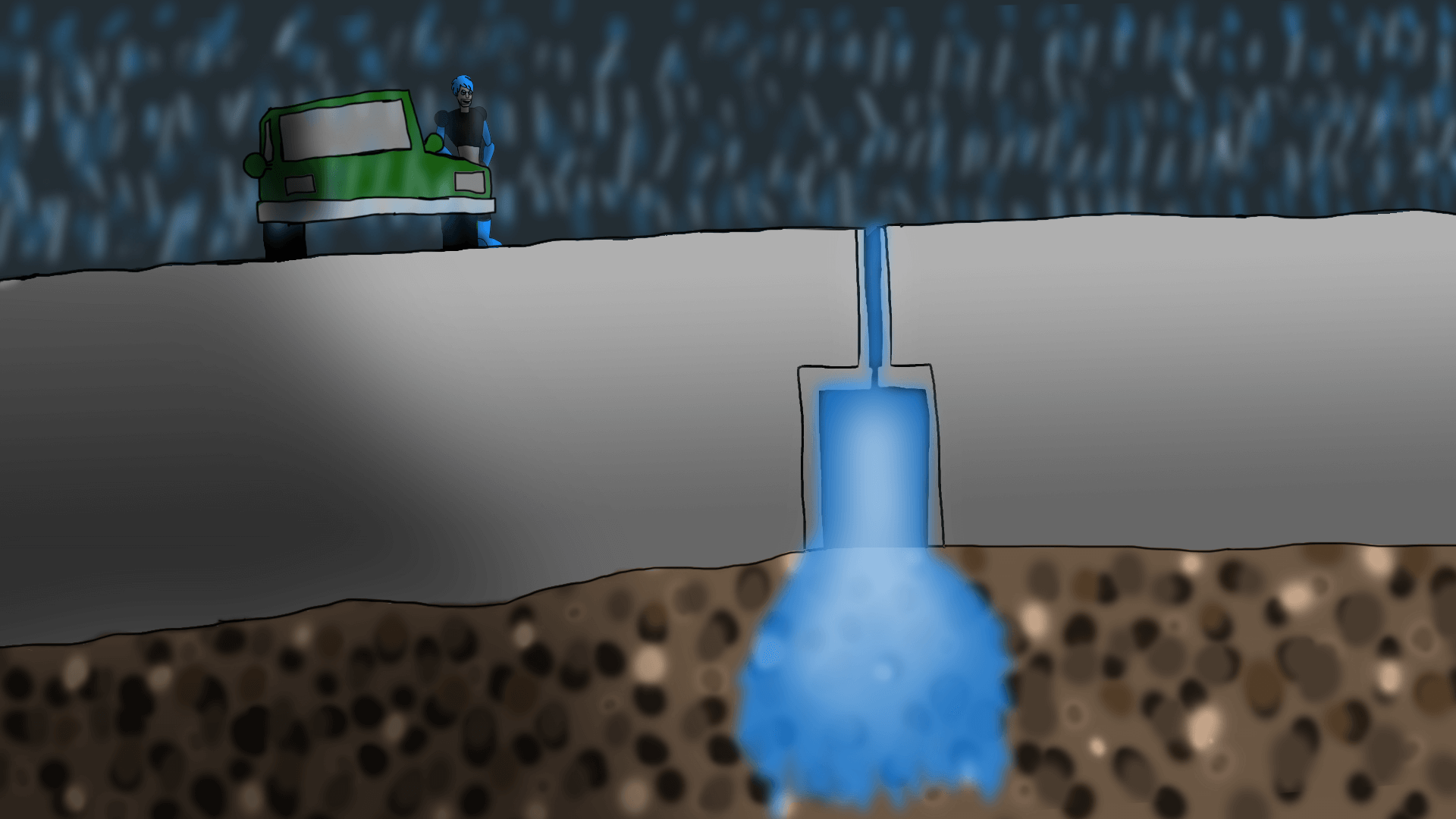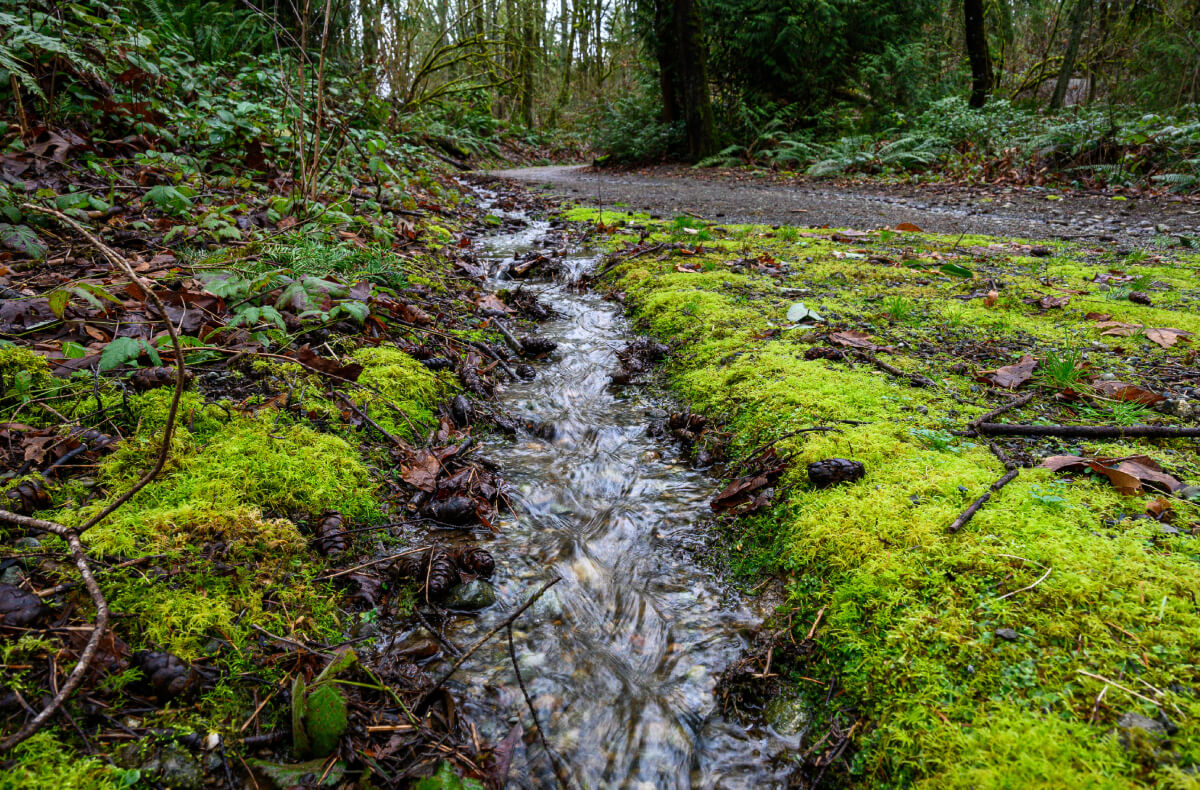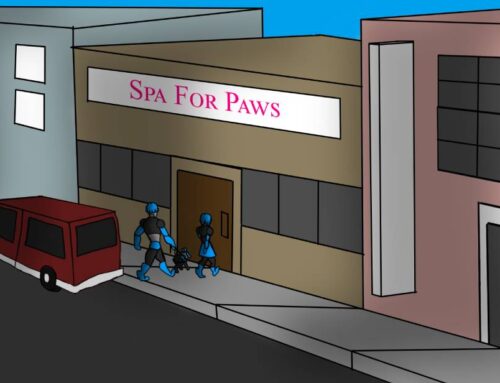Synopsis: Stormwater runoff can flood impervious surfaces and increase water pollution instead of returning to the ground to replenish aquifers.
Application: The D-Rain Joint® exterior, linear filter drain is a low-cost, durable, ADA-compliant, and low-maintenance way to divert and filter rainwater that accumulates on impervious surfaces.
Architect Mark Edgers clicked the dashboard icon on his computer that immediately brought up what he ruefully referred to as the most accurate weather money can buy. It confirmed what the darkening sky suggested: the rainy season was definitely underway.

Not unexpected—it happened in the near-desert climate of Noblesse each year about this time with the usual variations in rainfall amount and effect. In fact, several neighboring areas had already reported a few monsoon bursts ushering in the “season,” but nothing of the magnitude of the approaching storm Mark saw on his computer screen.
This time, however, more than rain might be falling. Mark had specified a new technology to handle heavy rain and runoff on the parking grounds and other large paved areas on the newly finished Noblesse Civic Center and, if the results were not as he had hoped, his professional stock could wash out as well.
His phone rang. A glance at the caller display identified J.T. Mallory, the lead developer on the Noblesse Civic Center project. He was one of the fairest and most open-minded professionals Mark had ever worked with. Still, he knew that rain handling was the last hurdle the new center would have to clear and if it failed, J.T. would hang him out to dry, literally and figuratively.
Mark clicked the talk button.
“Got your umbrella, Mark?” J.T. chuckled. “Looks like you could get a little rain today.”
Four months earlier
Despite the size and complexity of the Noblesse Civic Center development, the project was progressing smoothly and efficiently—and with much fanfare and anticipation from every segment of the city’s population. Such enthusiasm had sparked an unusual spirit of cooperation and compromise among all factions.
The Center’s planned municipal offices and training rooms would make it the hub for all civic activities. Recreational and fitness spaces would rival a university field house. Flexible meeting facilities would accommodate every size and age group from preschoolers to seniors. Outdoor spaces were designed for open air markets, art shows and craft fairs, and would connect by walking trails meandering through carefully landscaped displays of hardy, drought-tolerant, native flora.
What Mark would have anticipated to be the area of least contention had turned out to be a line drawn in the sand: the expansive areas planned for the parking lot. The acreage chosen for the Civic Center had been a unanimous choice for its size and location. Unfortunately the edge of the property designated for parking as well as natural walking trails was prone to flash flooding. Local residents often found neighboring streets barricaded in seasonal rain bursts until rainwater coursing over the street had receded.
Everyone, it seemed, had strong feelings about the best way to cope with storm water runoff. There were the paver proponents, the storm drain grate supporters, the permeable-surface-at-all-costs champions, and the “I don’t care as long as it’s on budget” contingent.
Caught squarely in the middle of the debate was Mark, who wanted a robust, cost-effective solution that would be easily installed, low maintenance, and could tame the storm water excesses for useful application. He had promised to bring such a solution to the next general Civic Center forum, which was now less than two weeks away.
Mark had always been struck by the irony of flooding in an area that was extremely thirsty for rain most of the year. If only there were some way to harness that storm water—this was an idea he returned to frequently as the civic center development gained traction.
It was no wonder that an online trade article entitled Turning Storm Waters Green caught his eye. The article addressed runoff issues that Mark knew only too well, and also its potential to be an important water source for areas of chronic drought, refilling ground aquifers while reducing pollutants.
When the article referenced an interview with a B.O.T.S. (BioMicrobics Onsite Treatment Specialists, an intriguing amalgam of human and artificial intelligence), Mark reached for his phone and punched in the contact number in the article. He briefly explained his current problem and requested a consultation.
He expected a sales representative to visit, but on the appointed day, he looked up from his desk to see an outstretched blue and silver arm and heard a not-quite-human voice. “You must be Mark. I’m Robust and I have an idea that might help.”

Mark held his breath and took a second to process the fact he was about to have a conversation with a robot. He let the breath out slowly and replied, “I’m all ears.”
Robust recapped some of the rainfall stats for the area in the last decade and the issues that were impacted: the increasing water demands of a growing population, flash flooding, infrastructure challenges of the new Civic Center.
Mark soon forgot that he was listening to a robot as Robust began talking about an emerging technology called d-Rain Joint® rainwater management system that installs where a normal expansion joint would be in a poured surface or where curbing meets the street. The d-Rain Joint’s® drainage channels, Robust explained, divert rainwater into an aggregate filtering system that oxygenates the water and allows it to collect or percolate slowly into soil.
“Sounds smart,” Mark agreed, “But what does it look like? I have several Civic Center board members ready to skewer me if anything offends their aesthetic sensibilities.”
Robust showed a series of installation photos on his display screen. “Part of its appeal is that you really don’t see the d-Rain Joint® at all. At the surface it looks just like any expansion joint.”
“Okay,” Mark said, warming to the topic. “Let’s find the catch. Maintenance?”
“Oh, it’s very low maintenance,” Robust answered. “Simply clean the filter and replace it as necessary.”
Mark thought a bit, “Does it limit vehicular traffic?”
“Not at all,” Robust replied. “It stands up to heavy trucks, all vehicles. We install these where snow is an issue, too, and it can withstand snow removal equipment. But it accommodates lightweight vehicles, too. Wheelchairs easily roll over the d-Rain Joint®. Excellent ADA compliance.”
Mark sighed. “Then it must be the cost. I knew it sounded too good!”
“Tell you what, Mark. Let me get some measurements and I’ll get back to you. I think you’ll find d-Rain Joint® handles a budget as easily as it handles rain.”
Mark shook Robust’s robotic arm as he turned to leave. “Don’t disappoint me, Robust, I’m beginning to get my hopes up.”
When the estimate arrived, Mark discovered it was much less than the paver, grate, or grid solutions he’d been exploring. And he found himself looking forward to his upcoming meeting with the Center development principals.
As the room filled, Mark ran through the visuals and stats of d-Rain Joint® installations, peppered with testimonials that Robust had provided and Mark himself had contacted.
There were a few perfunctory questions, but when Grace Bennigan, the long-standing Civic Center board member who’d been quickest to nix anything she felt detracted from the development’s aesthetics, gave her nod of approval, the rest were quick to second Mark’s recommendation.
As he began gathering up the visuals he’d presented, Mark realized J.T. was still in the back of the conference room. “Any questions, J.T.?” Mark asked.
J.T. shook his head and said, “It’s your project and your call, Mark.” Then with a chuckle, he added, “How long can you tread water?”
Mark knew what that meant: “Your project, your call …your neck on the line…”
During the d-Rain Joint® installation, Mark learned not to be surprised if suddenly Robust appeared alongside, to the project crews’ delight. In these visits, Robust shared additional details about d-Rain Joint® technology and its effectiveness in other installations. The more Mark learned, the more confident he felt that d-Rain Joint® was the right choice for the Noblesse Civic Center.
Large drops of water were beginning to splash down when Mark reached the perimeter of the parking areas of the Civic Center. A Noblesse public works truck was already there, its bed loaded with barricades used to block off the street during flash flooding in seasons past. Mark grimaced and shook his head at the driver, who responded, “It’s a precaution, Mark. Just in case.”
Within minutes the large drops morphed into driving sheets of rain that all but obscured Mark’s view of the street. He kept his eye on the makeshift rain gauge he’d attached to his truck and watched the water level quickly increment upwards. He heard a tap on his window and turned to see Robust standing outside.
“Get in!” Mark urged. “You’ll get soaked.”
“It’s okay, Mark,” Robust replied, “I’m in my natural element out here!”
For the next hour, they watched as the level in the rain gauge approached four inches and waves of rain coursed down the pavement and disappeared effortlessly into the d-Rain Joint® installations.

Suddenly the rain ceased as quickly as it had started. The public works truck driver looked skyward, then turned to Mark, gave him a broad salute and an even broader grin, and drove off with its unused load of barricades.
Mark jumped out of his truck and was about to thank Robust as J.T drove up next to them. He gave them each a congratulatory high five.
Robust said, “Gentlemen, it’s been a pleasure. I hope we can work together again.” He waved goodbye and accelerated into the clearing sky.
Mark and J.T. stood on the parking lot, looking down at the d-Rain Joint® that for all appearances looked just as it did before the rain began.
J.T. suggested that Mark contact the Civic Center board and report how well d-Rain Joint® had handled the storm water runoff.
“Me?” Mark asked, “But I thought you’d probably want to—“
J.T. interrupted him. “Your project, your success … your call.”






